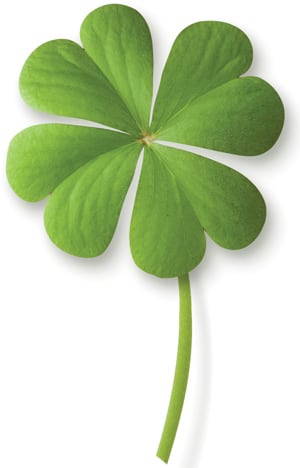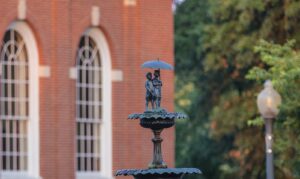There are many translations of St. Patrick’s lorica, the Deer’s Cry.
My favorite translation begins with these lines:
I bind unto myself today
The strong Name
of the Trinity,
By invocation of the same
The Three in One
and One in Three.
In spite of his popularity, especially in brew pubs in mid-March, not much is actually certain about St. Patrick.
According to the Catholic Church, he was born in 387 and died in 461, but there are questions about the accuracy of that information. He lived sometime in the 5th century. March 17 is celebrated as the date of his death, but scholars dispute the date as well as the date of his birth. There is even a theory that there were 2 Patricks who morphed into one Saint. Few details are agreed to. He was born in Britain when it was under Roman rule, but no one is sure where, and the location of his grave is also uncertain.
Most of what we know about Patrick is recorded in his Confessions. His father and grandfather were committed Christians, but Patrick was not initially an active believer. He was captured by a group of Irish pirates when he was 16 — although some suggest that he ran away to avoid municipal responsibility — and taken to Ireland, where he herded sheep for his master. During his time in captivity, he became a devout Christian. He also became fluent in the Irish language and culture, which served him well in later years. In his early 20s he heard a voice telling him to travel to the coast, where he would find passage back to Britain. Once in Britain he was able to reunite with his family.
A few years later he had a vision that convinced him he was to go back to Ireland as a Christian missionary. He studied for the priesthood, was later ordained as a bishop, and arrived back in Ireland in — maybe — 433. He is thought to have baptized 100,000 and established 300 churches in Ireland.
There are several legends, traditions, and symbols associated with St. Patrick.
- St. Patrick is often depicted with a cross or staff in one hand and a shamrock in the other. Legend has it that he used the 3-leaved shamrock to explain the Trinity, the triune God. It was helpful that the pagan Irish had several triple deities, so the notion of the Trinity fit right in.
- There are two kinds of crosses associated with St. Patrick: the cross pattée (aka the iron cross) and the red saltire (aka the diagonal cross or St. Andrew’s Cross).
- Legend has it that St. Patrick’s walking stick took root and grew into a tree. This happened during one of his evangelizing stops, when he spoke for so long that his staff, stuck in the ground, had taken root by the time he was ready to move on.
- Another St. Patrick legend is that he banished the snakes (symbolic of sin) from Ireland — there are no snakes in Ireland to this day. Naturalists insist, however, that there never were any snakes in Ireland …
In the 17th – 19th centuries, and even into the early 20th century, it was tradition in Ireland to wear a paper or ribbon cross on St. Patrick’s Day.
My favorite thing associated with St. Patrick is the lorica (hymn of protection) known as St. Patrick’s Breastplate or the Deer’s Cry. According to the 11th century Liber Hymnorum, St. Patrick sang this to protect himself and his monks from an ambush — his group passed by safely because the enemies saw a group of wild deer and a fawn rather than a group of men. The earliest fragments of the hymn appeared in a 9th century biography of St. Patrick’s life, and it has been reinterpreted into more modern translations in the past 1000 years.
Lady Luck
I was planning to title this article “St. Patrick and Lady Luck,” but as hard as it was to find solid information about St. Patrick, it was even more difficult to find out where Lady Luck came from. As a personification of luck, she seems to be descended from Tyche, the mythical Greek goddess of fortune, and from the Roman goddess Fortuna. I could find no references to Lady Luck before the 1930s.

Lucky Charm Traditions
It was also hard to find information about lucky charms — most of the searches brought up information and purchasing options for the General Mills cereal by the same name.
Four Leaf Clovers
 Four leaf clovers are thought to bring luck because they resemble a shamrock, which has 3 leaves. It’s a bit confusing because nearly all clover has 3 leaves; 4 leaf clovers are the exception, and do not represent the trinity. The 4 leaves are thought to offer faith, hope, love, and luck.
Four leaf clovers are thought to bring luck because they resemble a shamrock, which has 3 leaves. It’s a bit confusing because nearly all clover has 3 leaves; 4 leaf clovers are the exception, and do not represent the trinity. The 4 leaves are thought to offer faith, hope, love, and luck.
Rabbit’s Foot
 The rabbit’s foot is a lucky charm in regions on every continent. I was upset when I found out they are actual rabbits’ feet!
The rabbit’s foot is a lucky charm in regions on every continent. I was upset when I found out they are actual rabbits’ feet!
Horseshoes
 A horseshoe hanging near or on your door keeps evil from entering your house. Be sure to position it with the prongs facing up so your luck does not run out.
A horseshoe hanging near or on your door keeps evil from entering your house. Be sure to position it with the prongs facing up so your luck does not run out.
Lucky penny
 If you find a penny that is heads up, expect good fortune. If you find one that is tails up, turn it over and leave it so that the next person who sees it will enjoy good luck.
If you find a penny that is heads up, expect good fortune. If you find one that is tails up, turn it over and leave it so that the next person who sees it will enjoy good luck.
Finally, I cannot close without a nod to leprechauns, the color green, the number 7, and the pot of gold at the end of the rainbow.























